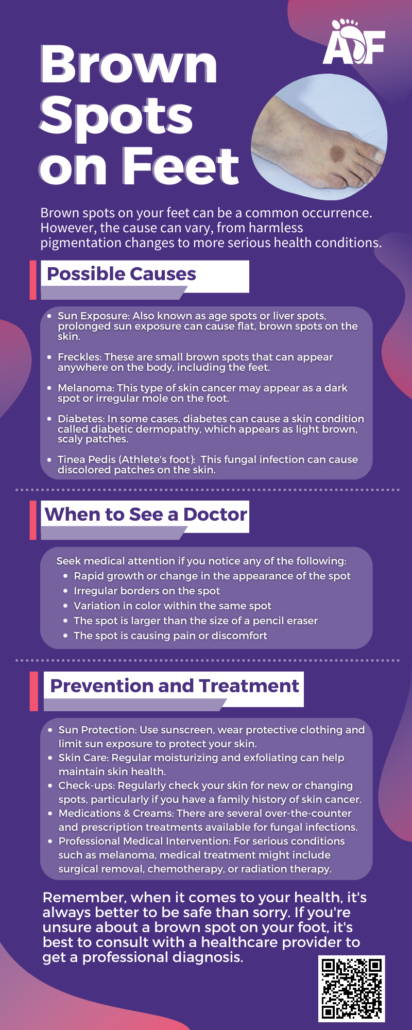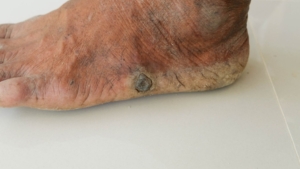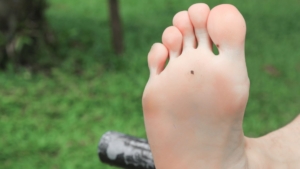Finding brown spots on your feet can be a little alarming. Skin is our largest organ and often the first indicator of our body’s internal health. So, when these unexpected visitors appear, it’s only natural to question their origin.
Often dismissed as a trivial aesthetic issue, these discolorations can sometimes signal underlying health concerns. It’s therefore essential to understand what could potentially cause them, how they can be treated, and what preventive steps you can take to keep your skin healthy and spot-free.
This comprehensive guide will serve as a resource, providing valuable insights into the causes, treatments, and prevention of brown spots on feet. Whether you’re trying to understand what’s causing these spots or seeking effective treatment options, this guide is designed to address your queries and concerns.
Stay with us as we unravel the mystery behind these brown spots and help you regain confidence in your skin. The journey towards healthier skin begins here, with knowledge and understanding. Let’s take the first step together.
Table of Contents
What are Brown Spots on Feet?
Brown spots on feet are a common skin condition that many people encounter at some point in their lives. They can appear in various shades of brown and differ in size and shape. Often these spots are harmless, merely an aesthetic issue, but they can also be a sign of more severe health problems. Therefore, recognizing them and understanding what they mean is important.
Describing Brown Spots
Brown spots on the feet, often referred to as pigmented lesions in the dermatology world, are areas where the skin has darkened. This darkening is due to an excess production of melanin, the pigment responsible for the color of our skin, hair, and eyes.
The spots can vary widely in appearance. Some may be small, like a speck of dust, while others can be larger and cover a more considerable part of the skin. They can be flat or raised, round or irregularly shaped. Some are uniformly dark, while others can have a gradient of shades.
Where Do They Appear?
Although the name suggests that these spots are exclusive to feet, that’s not entirely accurate. They can appear anywhere on the body but are more commonly found on areas exposed to the sun. On the feet, they often appear on the tops or soles and sometimes between the toes.
If you’ve noticed one or more of these spots on your feet, you might be wondering what has caused them. The next section will explore some of the most common causes of these brown spots. With a better understanding, you can take appropriate steps for treatment and prevention.
Common Causes of Brown Spots on Feet
Several factors can contribute to the appearance of brown spots on feet. They can range from external elements like sun exposure to internal conditions like aging or certain diseases. It’s crucial to identify the cause as it can directly impact the course of treatment.

Sun Exposure
Prolonged and unprotected exposure to the sun is one of the most common causes of brown spots on feet. The harmful ultraviolet (UV) rays of the sun can stimulate an overproduction of melanin, leading to the formation of these spots, medically known as solar lentigines or more commonly, sun spots.
Aging
As we grow older, our skin undergoes several changes. One such change is the appearance of age spots, also known as liver spots. These spots are flat, brown, gray, or black, and they usually occur in areas exposed to the sun, including the feet. They are harmless but can be a cosmetic concern for some.
Diabetes
People with diabetes can sometimes develop brown spots or patches on their skin, a condition called diabetic dermopathy. These spots occur due to changes in the small blood vessels that nourish the skin, and they are often found on the shins but can also appear on the feet.
Other Possible Causes
Besides sun exposure, aging, and diabetes, several other conditions can cause brown spots. These include melasma, a skin pigmentation disorder more common in women; acanthosis nigricans, characterized by dark, velvety patches in body folds and creases; and certain fungal infections like tinea versicolor.
It’s essential to remember that while these are common causes, brown spots can sometimes be a symptom of more serious conditions, including skin cancer. Therefore, any new or changing spots on the skin should be evaluated by a healthcare provider or a dermatologist.
Identifying Brown Spots on Feet
With numerous skin conditions appearing similar to brown spots, correct identification becomes crucial. While it’s recommended to consult a medical professional for an accurate diagnosis, some characteristics can help distinguish these spots.
Differentiating Brown Spots
Several skin conditions can mimic the appearance of brown spots. Freckles, moles, and melanoma (a type of skin cancer) can all present as brown spots. However, they each have unique features.
For instance, freckles are small, usually lighter in color, and often increase in number with sun exposure. Moles are usually raised and can appear anywhere on the body, while melanoma spots often have irregular borders, varying colors, and a rapid increase in size.
Brown spots due to aging or sun exposure are typically flat and uniform in color, unlike these other conditions.
When to See a Doctor
It’s crucial to see a doctor if you observe any changes in the size, shape, or color of the spots. Any itching, bleeding, or redness around the spots should also prompt a medical consultation.
Moreover, if the number of spots is increasing rapidly or if they are affecting your self-esteem and mental well-being, a visit to the dermatologist would be beneficial.
Don’t let foot discomfort hold you back any longer.
Take control of your foot health today.
The Process of Diagnosis
Dermatologists diagnose brown spots through a careful examination, considering the patient’s medical history, symptoms, and the spots’ characteristics. In some cases, a procedure called a biopsy might be performed, where a small skin sample is taken and examined under a microscope to rule out serious conditions like melanoma.

Understanding what’s causing your brown spots is the first step toward effective treatment. The next section will explore various treatment options that can help manage and potentially eliminate these spots.
Treatment Options for Brown Spots on Feet
 Brown spots on feet, whether caused by aging, sun exposure, diabetes, or other factors, can often be managed with a variety of treatments. The choice of treatment depends on the underlying cause, the extent of the discoloration, and the individual’s preferences.
Brown spots on feet, whether caused by aging, sun exposure, diabetes, or other factors, can often be managed with a variety of treatments. The choice of treatment depends on the underlying cause, the extent of the discoloration, and the individual’s preferences.
Over-the-Counter Treatments
Several over-the-counter (OTC) treatments can lighten or eliminate brown spots. These include creams, lotions, and serums that contain active ingredients such as hydroquinone, glycolic acid, kojic acid, retinoids, and vitamin C. They work by reducing the production of melanin, promoting skin cell turnover, or both.
Prescription Treatments
If OTC products are ineffective, a healthcare provider may recommend prescription-strength creams or lotions. These typically contain higher concentrations of active ingredients, making them more potent.
Home Remedies
Home remedies can sometimes help lighten brown spots, though they’re typically less effective than OTC or prescription treatments. They include remedies like applying lemon juice, aloe vera, apple cider vinegar, or green tea to the affected areas. However, these remedies should be used with caution as they can sometimes irritate the skin.
When to Seek Professional Help
 If self-care measures don’t help, professional treatments are available. These include laser therapy, intense pulsed light treatment, cryotherapy, microdermabrasion, and chemical peels. These procedures should be conducted by trained professionals to avoid potential complications.
If self-care measures don’t help, professional treatments are available. These include laser therapy, intense pulsed light treatment, cryotherapy, microdermabrasion, and chemical peels. These procedures should be conducted by trained professionals to avoid potential complications.
While treatments can help manage existing spots, prevention is the key to avoid future ones. In the next section, we’ll discuss preventive measures you can take to keep your skin healthy and spot-free.
Preventing Brown Spots on Feet
While brown spots are not always preventable, particularly when they are linked to aging or certain medical conditions, there are a few strategies that can minimize their appearance or prevent new spots from forming.
Sunscreen and Protective Clothing
Since sun exposure is a significant factor contributing to brown spots, protecting your skin from harmful UV rays is crucial. Apply a broad-spectrum sunscreen with an SPF of 30 or higher every day, even on cloudy days, and reapply every two hours when outside for extended periods. Additionally, wear protective clothing like wide-brimmed hats, long-sleeved shirts, and sunglasses.
Regular Skin Check-ups
Regular self-examination of your skin can help detect new brown spots or changes in existing ones. If you notice any changes, make sure to consult a dermatologist. Regular check-ups with a healthcare provider can also help detect any underlying conditions causing the spots.
Healthy Lifestyle Habits
Maintaining a healthy lifestyle can go a long way in preventing brown spots and promoting overall skin health. This includes a balanced diet rich in antioxidants, regular exercise, adequate hydration, and sufficient sleep.
It’s important to note that while brown spots can be a cosmetic concern, they are a normal part of aging and sun exposure. However, in some cases, they might indicate an underlying health issue. In the following section, we’ll discuss what it’s like to live with brown spots on your feet and how to cope with them.
Living and Coping with Brown Spots on Feet
 Dealing with brown spots on feet might bring about some concern, especially if you’re unsure of their cause. However, most brown spots are benign and do not affect your health or longevity. Here are some tips to help you cope with brown spots.
Dealing with brown spots on feet might bring about some concern, especially if you’re unsure of their cause. However, most brown spots are benign and do not affect your health or longevity. Here are some tips to help you cope with brown spots.
Adopt a Positive Mindset
While it’s natural to worry about any changes in your body, remember that brown spots on feet, especially those related to aging or sun exposure, are typically harmless. Embrace them as part of your individuality. If the spots are causing significant distress, consider speaking to a mental health professional.
Care for Your Skin
Taking care of your skin goes beyond aesthetic appeal. It involves protecting it from damage and keeping it healthy. Ensure you maintain a skincare routine that suits your skin type and addresses your specific needs. This includes daily cleansing, moisturizing, and sun protection.
Stay Informed
Stay updated on the latest research and advancements related to skin health. The more informed you are, the better equipped you’ll be to take care of your skin and address any issues that arise.
Consult Professionals When Needed
Finally, never hesitate to consult a dermatologist if you have any concerns about your skin. They can provide accurate information, diagnose conditions, and recommend treatments.
Remember, your skin is unique to you. It tells a story about your life, your health, and your experiences. Embrace it, take care of it, and seek help when you need it.
Conclusion
Discovering brown spots on your feet can be surprising and even worrying. However, it’s important to remember that most brown spots are harmless and part of the skin’s natural aging process. They can be a result of various factors, including sun exposure, aging, or certain medical conditions.
Identifying the cause of these spots is the first step towards effectively managing them. While over-the-counter treatments, prescription creams, and home remedies can help lighten brown spots, professional treatments may be needed in some cases. Furthermore, adopting preventive measures like using sunscreen, having regular skin check-ups, and maintaining a healthy lifestyle can go a long way in preventing new spots from forming.
Although brown spots can be a cosmetic concern, they are often benign and don’t affect your health. Still, any changes in your skin should be evaluated by a healthcare provider to rule out serious conditions. Always remember, your skin is a part of your identity. Embrace it, care for it, and consult professionals when in doubt. With the right knowledge and approach, you can confidently navigate any skin changes that come your way.





